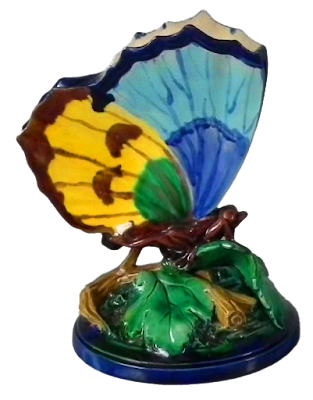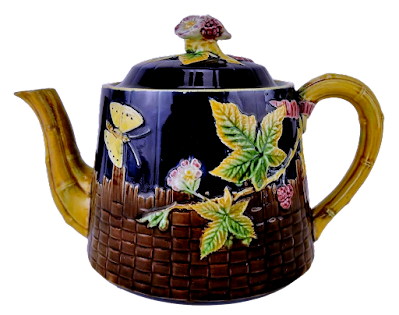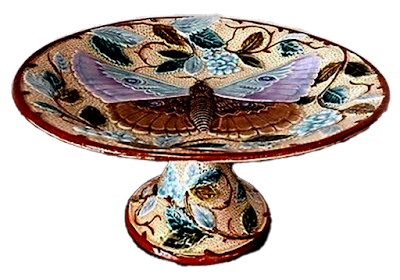An inevitable result of the decoration of the Aesthetic Movement is that all manner of creatures from the natural world would appear in majolica. The least expected might be the lowly insect but as things would have it insect decoration on majolica has created some of the most stunning examples of form. The subject is so large we're going to look at the use of insects in two posts: Butteries and Moths first and; Beetles, Flies, Dragonflies and Other Insects next.
In world culture butterflies have been believed to symbolize the human soul, the path of life and immortality. In Christianity butterflies represent spiritual rebirth and have been thought to communicate messages from angels. In Chinese and ancient Greek legend the butterfly represents immortality while in Japanese culture a white butterfly represents the soul of an ancestor, a surprisingly common belief among many different cultures. In Native American culture a desire whispered to a butterfly will grant divine approval.
Moths are similar to butterflies in meaning but also take a darker turn: the desire to reach beyond one's grasp. The moth is attracted to the flame but is often burned in the process. A white moth is believed to represent the soul of a child.
The most famous of the many, many, representations of moths and butterflies in majolica may be the Minton butterfly plate but equally gorgeous pieces were made by all the major potteries. Let’s begin with with the boldest of these pieces, the giant butterfly from the Massier pottery. This large, impressive piece is terribly rare but oh so glorious!
Massier used butterflies and moths in other pieces as well, most beautifully as decoration for their jardinieres and wall pockets.
I mentioned the Minton butterfly plates earlier and they are extraordinary! There are at least 13 different different designs that I know of as well as sold colored examples. They are shown here in this page from the Minton archive. These designs were just a guide as the colors could vary from plate to plate. The plates were made in both majolica and decorated earthenware.
Minton incorporated butterflies and moths as decoration in other pieces such as this wonderful woodpecker vase.
An equally famous group of butterfly wares were made by George Jones. The large orchid and butterfly dresser plaque is stunning as are all of the other pieces where Jones uses butterflies and moths. Butterflies were also often used as finials in some hollowware pieces
Wedgwood made its share of majolica butterflies as well, most notably in applied decoration in the Tremblay and Key patterns and molded into the design of the Lincoln and Tropic patterns.
Wardle has a Fan series that includes butterflies.
Copeland used butterfly decor on this stunning jardiniere.
Banks & Thorley sometimes used butterfly handles in their Bamboo series of pitchers and tea hollowwares.
Brown-Westhead Moore used butterflies in their Wicker design and on this moon vase.
Forester used a butterfly in their butterfly lip pitcher and Shorter & Boulton made a nice basket.
This lovely Victoria Pottery basket featured a butterfly.
In America, the Etruscan Works––Griffen, Smith and Company––also had pieces with butterflies on their butter dish, wall pocket, Lily cheese bell, an ash tray and their version of the Forester butterfly lip pitcher.
Lastly, you can’t talk about majolica moths and butterflies without mentioning the Palissy pieces from Portugal and France. You would be hard pressed to find a palissy plaque without at least one little insect critter worked into the design, quite often a moth or butterfly as in these three pieces from Joseph Cunha of Caldas and these unmarked French Palissy vases and plaques show. We'll tie up this section with a Caldas palissy butterfly wall pocket.





















































































Great comprehensive research and a wonderful array of photos! Well done!
ReplyDeleteThanks Linda!
Delete